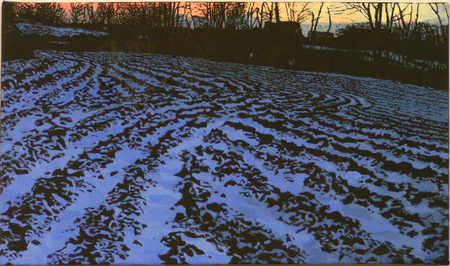WCC exhibit showcases two artists' views of rural lands

"Snowfield No. 10" by Elaine Wilson
“Looking at the Land: The Rural View” at Washtenaw Community College’s GalleryOne reflects our Midwest landscape with uncommon, supremely artistic nuance.
Combining University of Michigan professor emeritus John Stephenson’s ceramic sculpture with oil paintings of varying size by Washtenaw Community College art instructor Elaine Wilson, the exhibit works because both artists ground their art in the physicality of terra firma. Stephenson's ceramics have a density that contrasts nicely with Wilson’s landscapes, and what might have been otherwise disparate art is instead conceptually unified.
There’s a hard-earned muscularity in Stephenson's ceramics that seems almost welded together. As he says in his artist’s statement, “The turning of the rich black earth in the farm fields of Iowa made a strong visual impression on me. While I wasn’t reared on a farm, I could easily appreciate the farmer’s stewardship of the land.
“After years of tilling the earth in my own vegetable garden,” continues Stephenson, “a metaphor between the tool churning the earth and the clay work in my studio began to evolve. My intention is to somehow visually express the spiritual bond between man the tiller of the earth and the turned earth itself.”
Consider Stephenson’s ceramics as being a success. In some of his sculpture — for example, the sturdy “Chariot No. 2 ”— Stephenson’s work is structured in such a manner that the four mottled ceramic axels holding the form are seemingly fastened together to grind the earth as needed. The work’s cylinder — from which its curved fingers extend — is the essential agency of the grain’s release from straw and chaff.
“Twisted Earthscape No. 5,” on the other hand, is a far more abstract rendering that finds Stephenson taking pleasure in the solidity of his material. A handsome oversized, multi-colored ceramic wedge whose titanic twists suggests an oversized saddle; “Twisted Earthscape No. 5” is all sculptural muscle with a surface marked by colorful patches and bruises. This ceramic, like the best of Stephenson’s work, reflects a solid strength.
Elaine Wilson’s paintings superbly match Stephenson’s ceramics because of her unassuming view of rural America. While Stephenson’s work illustrates strength, Wilson’s views of our countryside are largely calm — often pastoral.
There’s a cool objectivity in Wilson’s paintings that almost makes them (so to speak) reports from the field. Working in differing sizes and scales, Wilson may opt to depict a bird’s-eye view of the landscape (“Humid Summer Morning”) or create a more intimate close-up (Spring Morning with Cows”).
“Some of the paintings,” Wilson says in her gallery statement, “are simply about being in a place and trying to find an equivalent in paint and mark for the movement of earth, plants, tractor ruts, erosion, contrails, (and) clouds.
“Some of my paintings tell a larger story. The large farm paintings bring many events together onto one canvas, none of which happen at the same time, and although they are constructed from drawings and small paintings done on site in a specific place, the resulting painted space is my invention.”
Fusing these approaches, Wilson’s contributed two remarkable views of a tilled countryside in midwinter. Her “Snowfields No. 7 and No. 10” are magnificent artworks by any standard.
These paintings depict fallow settings just before the last glimmer of light. Wilson’s confluence of blue and white snow-lined furrows is vividly set against a mottled sky throwing indirect light that heightens the field’s undulating shadows.
In a world of far-too-busy distraction, Wilson’s “Snowfields” are not merely superior works of art—they are, rather, spirited mediations on nature that are as extraordinary as they are striking. They’re easily the next best thing to actually having been there.
“Looking at the Land: The Rural View” continues through December 17 at Washtenaw Community College GalleryOne, Student Center Building Room 108, 4800 East Huron River Drive. Gallery hours are 10 a.m.-6 p.m. Monday-Tuesday; 10 a.m.-8 p.m. Wednesday-Thursday; and 10 a.m.-noon Friday. For information, call 734-477-8512.

